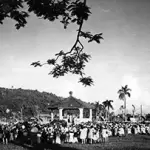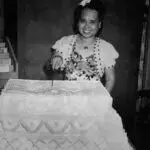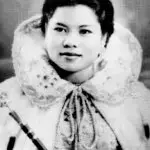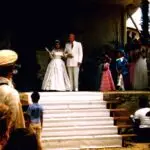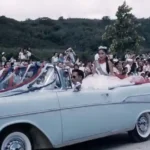Guam Liberation Day
Table of Contents
Share This
Guam's biggest celebration
After World War II was over community leader Agueda Iglesias Johnston convinced US military leaders on Guam to support a celebration to commemorate the Liberation of the island from the Japanese. It was enacted into law in 1951 in Bill 35 sponsored by Speaker Antonio B. Won Pat. This celebration continues to this day as one of Guam’s holidays – Liberation Day, which is celebrated on July 21st.
While there were Liberation Day commemorations in the late 1940s and then Liberation Day celebrations in the early 1950s, the first Liberation Day queen contest wasn’t held until 1948. Beatrice Blas Calvo Perez was the first Liberation Day Queen of Guam. The winner was declared based on ticket sales, just as it is today.
Follows the pre-war tradition of annual fairs
Before the outbreak of World War II on Guam, some of the most anticipated events were the annual fairs held at the historic Plaza de España in Hagåtña and later at the Bradley Park in Anigua. The Guam Island Fair was an opportunity to show off an array of talent, competition, display prized products and socialize. There were always queens that graced the fair grounds with all their beauty, pride and splendor.
Today, the committee that plans Liberation Day is still called the Guam Island Fair committee.
Liberation Day festivities include a queen contest, a summer carnival and a mile long parade on Marine Corps Drive in Hagåtña. Thousands participate by making floats or marching in the parade along with the US military. More recently various ethnic groups, including the Japanese, take part in the parade as well, showing their love for Guam.
Solemn commemorations at massacre sites in Merizo, Hågat, Yona and Yigo as well as the Asan Overlook and other World War II memorials are also held at this time.
Multi-day extravaganza
Guam’s celebration of Liberation is not confined to just one day. Since its beginning, the events have always been a multi-day extravaganza. In past Liberation celebrations, activities have included sports events (including boxing and wrestling), agricultural fairs, bicycle races, greased pig catching competitions, a battle of the bands in 1971, and even a circus.
Traditionally though, the events include religious and memorial services, the Liberation queen contest, a carnival, and of course, the parade. The parade route is from Adelup to the Paseo de Susana.
The route has been changed in the past, however. In 1976 it started at Adelup and ended at Camp Asan. In 1983 it started at Adelup and ended at the Hagåtña pool, rather than Paseo.
The carnival’s location has changed over the years as well. While it is usually at Paseo it has been held at the former Yigo Amusement Park, the Harmon Cliff line, and Tiyan.
Village floats are best loved in the parade
The parade floats are both commercial and civic. The village floats are the best loved, as volunteers from many of the villages get together to create floats using natural materials to represent the theme for the year. Oftentimes the floats include hanging fresh fruits and betelnut that is thrown to the parade watchers, or live performances that go on for the whole parade.
Some dedicated parade watchers line up hours before the sign-up sheet for parade spots becomes available. Parade spots are given on a first-come, first-served basis. Families and businesses usually set up their tents the night before and camp out before the parade happens on Liberation Day, usually starting at 10 am.
During the parade, the parade route is shut down, the grand marshal leads the bands, marching units, and floats. Government officials make speeches, there are musical performances, and spectators watch, barbecue, and celebrate.
And if people don’t want to brave the extremely hot and sometimes rainy weather, they can also watch from the comfort of their homes. The parade has been broadcasted live by PBS GUAM since 1995.

